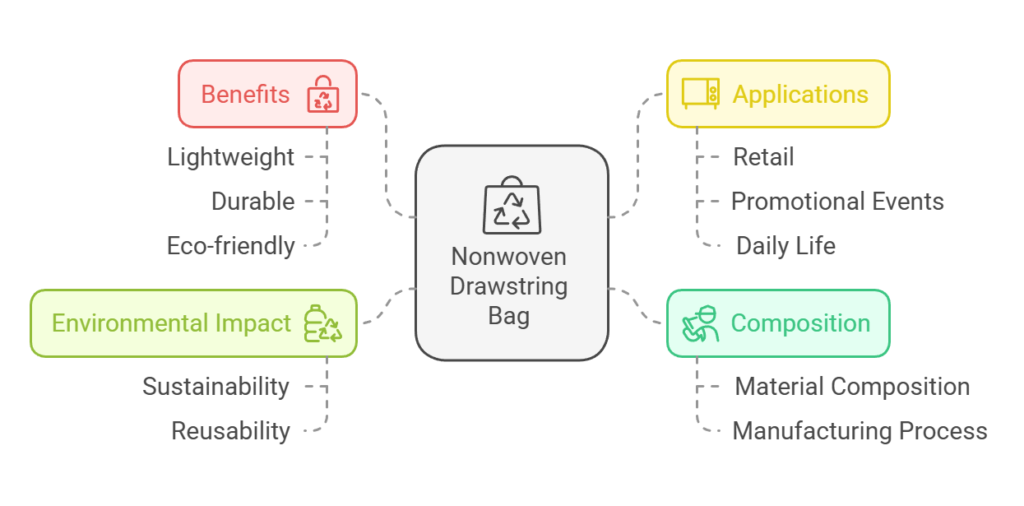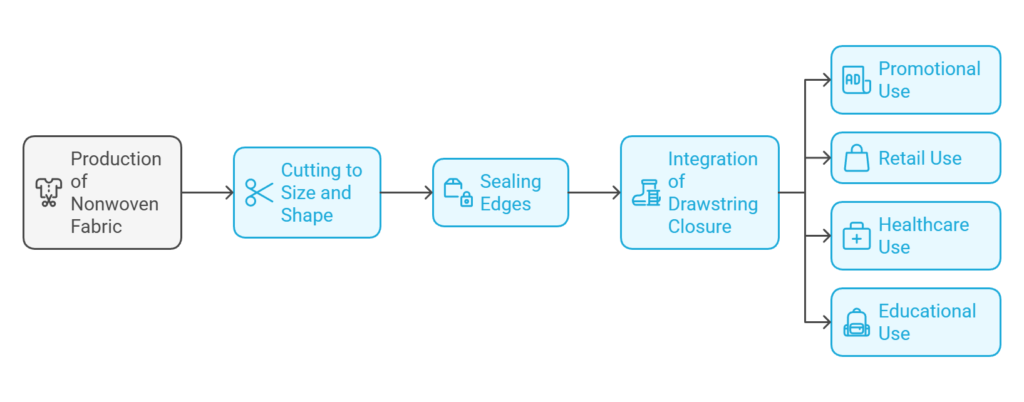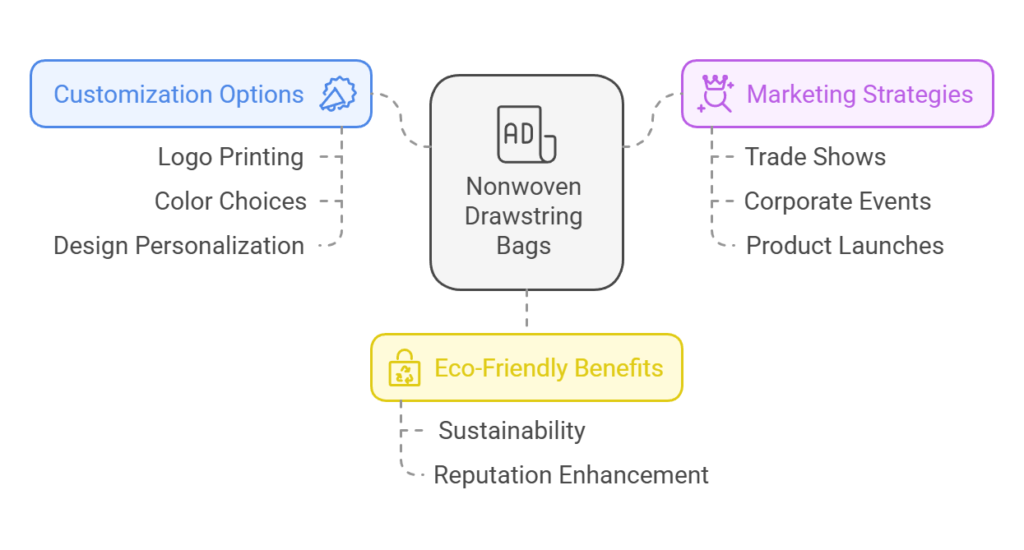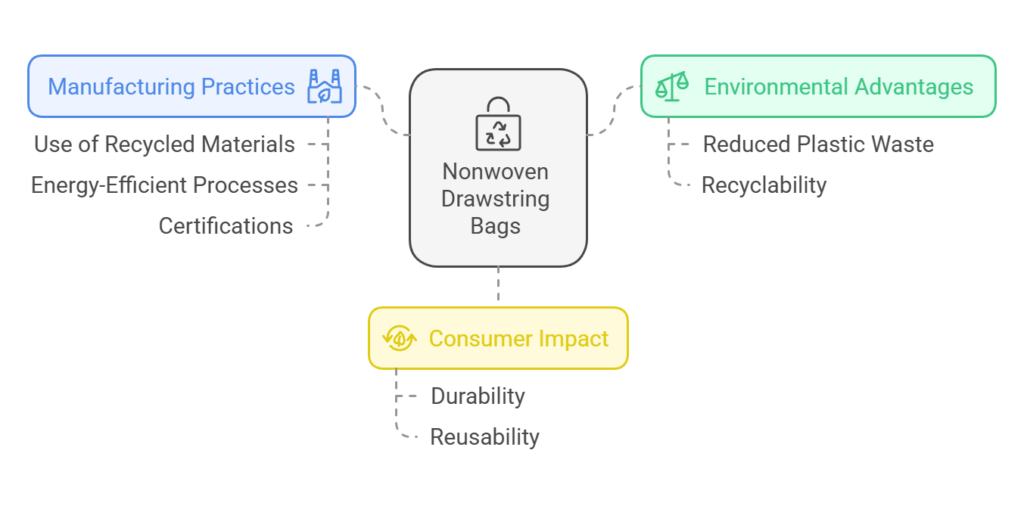Introduction
What is a Nonwoven Drawstring Bag? This question may arise in the minds of individuals who are exploring sustainable and versatile options for packaging or carrying items. A nonwoven drawstring bag is a type of bag made from nonwoven fabric, characterized by its lightweight, durable, and eco-friendly properties. Unlike traditional woven fabrics, nonwoven materials are created by bonding fibers together through chemical, mechanical, or thermal processes, resulting in a fabric that does not require weaving or knitting.

Nonwoven drawstring bags have become increasingly popular due to their numerous advantages. They are often used in various industries, including retail, promotional events, and even in daily life, for carrying groceries, gym clothes, or personal items. The drawstring closure mechanism is another feature that adds to their convenience, allowing for easy opening and secure closure, making them an ideal choice for a wide range of applications.
This article delves into the specifics of nonwoven drawstring bags, exploring their composition, benefits, uses, and environmental impact. By understanding the characteristics and advantages of these bags, readers can make informed decisions when choosing sustainable packaging or carrying solutions. Whether you are a business owner looking for promotional items or an individual seeking a reliable and eco-friendly bag, nonwoven drawstring bags offer a practical solution that aligns with modern environmental consciousness.
As we proceed, we will examine the various aspects of nonwoven drawstring bags, from their material composition to their diverse applications, highlighting why they have become a preferred choice in today’s market. This comprehensive overview will provide valuable insights into the significance and utility of nonwoven drawstring bags, setting the stage for a deeper understanding of this innovative product.
Official Answer
A nonwoven drawstring bag is a type of bag made from nonwoven fabric, which is a material produced through the bonding of long and short fibers using chemical, mechanical, heat, or solvent treatments, rather than weaving or knitting. The nonwoven fabric is known for its strength, durability, and flexibility, making it a popular choice for a variety of applications.

The construction of a nonwoven drawstring bag typically involves a single piece of nonwoven fabric that is cut to the desired size and shape. The edges are then sealed, often through ultrasonic welding or heat sealing, to create a seamless and durable product. The drawstring closure is integrated into the top hem of the bag, allowing for easy opening and closing. This closure system is not only convenient but also secures the contents of the bag effectively.
The primary uses of nonwoven drawstring bags are varied and extensive. They are commonly employed as promotional items due to their customizable surfaces, making them ideal for printing logos, slogans, or artwork. Additionally, these bags are frequently used in retail settings as reusable shopping bags, thanks to their sturdy construction and eco-friendly nature. In the healthcare industry, nonwoven drawstring bags serve as hygienic storage solutions for medical supplies. They are also popular in educational environments, often used by students for carrying books and personal items due to their lightweight and resilient design.
Overall, nonwoven drawstring bags combine practicality with sustainability, making them a versatile choice for both everyday use and specialized applications. Their ease of production and cost-effectiveness further contribute to their widespread adoption across various sectors.
Materials and Manufacturing Process
Nonwoven drawstring bags are primarily crafted from nonwoven fabrics, with polypropylene being one of the most commonly used materials. Polypropylene is a thermoplastic polymer known for its durability, lightweight nature, and resistance to chemicals and moisture. These attributes make it an ideal choice for creating reusable and eco-friendly bags that can withstand daily wear and tear.

The manufacturing process of nonwoven drawstring bags begins with the production of the nonwoven fabric itself. This fabric is made by bonding fibers together using various methods such as chemical, thermal, or mechanical techniques, rather than weaving or knitting. The result is a fabric that is strong, flexible, and cost-effective.
Once the nonwoven fabric is ready, it undergoes a series of steps to transform it into a functional drawstring bag. The first step is cutting the fabric into the desired shapes and sizes using precision cutting tools to ensure uniformity and minimize waste. These fabric pieces are then stitched together using industrial sewing machines, which provide strong and durable seams capable of holding substantial weight.
After the bag structure is complete, the drawstring mechanism is added. This involves creating a top hem in which the drawstring cord can be threaded. The cord, often made from materials such as cotton, polyester, or nylon, is then inserted through the hem and secured to form the closure system. This drawstring mechanism allows for easy opening and closing of the bag, enhancing its functionality and convenience.
Nonwoven materials offer unique properties that make them particularly suited for drawstring bags. They are breathable, which helps in maintaining the freshness of the contents. Additionally, nonwoven fabrics are resistant to tearing and can be easily customized with various printing techniques, making them an excellent choice for promotional and branding purposes. The combination of these properties ensures that nonwoven drawstring bags are not only practical but also versatile and durable.
Benefits of Nonwoven Drawstring Bags
Nonwoven drawstring bags have gained significant popularity due to their distinct advantages over traditional plastic or woven fabric bags. One of the primary benefits of nonwoven drawstring bags is their durability. Unlike plastic bags, which can tear easily under pressure, nonwoven drawstring bags are made from strong, bonded fibers that provide enhanced strength and resilience. This makes them an ideal choice for carrying heavier items without the risk of breakage.

Another notable benefit is their lightweight nature. Nonwoven drawstring bags are significantly lighter than their woven fabric counterparts, making them convenient and easy to carry. This characteristic is particularly advantageous for daily use, travel, and outdoor activities where weight considerations are crucial.
Eco-friendliness is a key attribute that sets nonwoven drawstring bags apart. In an era where environmental consciousness is paramount, these bags offer a sustainable alternative to single-use plastic bags. Nonwoven materials are often biodegradable and recyclable, reducing the ecological footprint associated with their use. Additionally, the production of nonwoven bags typically consumes fewer resources and generates less waste compared to the manufacturing of plastic or woven fabric bags.
Cost-effectiveness is another compelling reason to choose nonwoven drawstring bags. They are generally more affordable to produce and purchase, offering excellent value for money. This cost-efficiency does not compromise quality, making nonwoven drawstring bags a budget-friendly option without sacrificing durability or functionality.
When comparing nonwoven drawstring bags to plastic or woven fabric bags, the benefits become clear. Plastic bags, while cheap, contribute significantly to environmental pollution and lack durability. Woven fabric bags, though durable, can be heavy and more expensive. Nonwoven drawstring bags strike a balance, providing a lightweight, durable, eco-friendly, and cost-effective solution for various carrying needs.
Common Uses and Applications
Nonwoven drawstring bags have become increasingly popular across various industries due to their versatility, durability, and cost-effectiveness. These bags are frequently utilized for promotional giveaways, offering a practical and reusable option for companies aiming to increase brand visibility. During trade shows, conferences, and corporate events, nonwoven drawstring bags often serve as the go-to choice for distributing informational materials, samples, and branded merchandise. Their lightweight nature and ease of customization make them an ideal marketing tool.

Another prominent application of nonwoven drawstring bags is in the realm of fitness and sports. Gym-goers and athletes find these bags convenient for carrying workout gear, shoes, and personal items. Their breathable material helps in reducing odor and allows for easy cleaning, which is particularly beneficial in a gym setting. As a result, fitness centers and sports clubs frequently offer branded nonwoven drawstring bags as part of their membership packages or promotional campaigns.
In addition to their promotional and fitness-related uses, nonwoven drawstring bags have also gained traction in the retail and grocery sectors. Many consumers prefer these bags for their shopping needs due to their sturdiness and reusability. Retailers often provide these bags as a sustainable alternative to single-use plastic bags, thereby promoting environmentally friendly practices. Grocery stores and farmers’ markets also endorse the use of nonwoven drawstring bags by offering them as part of their loyalty programs or for a nominal fee.
Moreover, educational institutions and event planners find nonwoven drawstring bags to be highly functional for students and attendees. Schools and universities often distribute these bags during orientation sessions, open houses, and school events, offering a practical way for students to carry books, supplies, and personal items. Similarly, event organizers utilize these bags to create welcome kits for participants, filled with necessary materials and souvenirs, enhancing the overall event experience.
Overall, the widespread adoption of nonwoven drawstring bags across various sectors underscores their practicality and adaptability. From promotional giveaways to everyday use, these bags continue to offer a multifaceted solution for diverse needs.
Customization and Branding
Nonwoven drawstring bags offer a versatile and cost-effective solution for businesses looking to enhance their branding and marketing efforts. These bags can be easily customized to reflect a company’s unique identity, making them an ideal choice for promotional activities. One of the most common customization options is logo printing, which allows businesses to prominently display their brand on the bag. This can be done using various printing techniques such as screen printing, heat transfer, and digital printing, each offering different advantages in terms of durability and color fidelity.

In addition to logo printing, nonwoven drawstring bags can be personalized with a wide range of colors and designs. Companies can choose from an array of fabric colors that align with their brand’s aesthetic, ensuring consistency across all promotional materials. Custom designs can also be added to the bags, incorporating elements such as patterns, slogans, and images that resonate with the target audience. These bespoke elements not only enhance the visual appeal of the bags but also make them more memorable for consumers.
Beyond aesthetics, the customization of nonwoven drawstring bags serves a strategic purpose in marketing and promotions. When used as giveaway items at trade shows, corporate events, or as part of a product launch, these bags help to increase brand visibility and recognition. Recipients of the bags are likely to use them in their daily lives, inadvertently promoting the business to a broader audience. Additionally, the eco-friendly nature of nonwoven materials can enhance a company’s reputation for sustainability, appealing to environmentally conscious consumers.
Overall, the ability to customize nonwoven drawstring bags with logos, colors, and designs makes them an effective tool for branding and marketing. By leveraging these options, businesses can create unique, eye-catching promotional items that leave a lasting impression on their audience.
Environmental Impact
Nonwoven drawstring bags offer significant environmental advantages over traditional plastic bags, making them a favorable choice for eco-conscious consumers. One of the primary benefits is their reduced environmental footprint. Unlike single-use plastic bags, nonwoven drawstring bags are designed for multiple uses, thereby decreasing the volume of waste generated.

In terms of recyclability, nonwoven bags are generally made from polypropylene, a type of plastic that is widely accepted in recycling programs. This means that at the end of their life cycle, these bags can be recycled into new products, reducing the need for virgin materials and helping to mitigate plastic pollution. In contrast, conventional plastic bags are often not recyclable and contribute significantly to landfill waste and marine pollution.
Additionally, many manufacturers of nonwoven drawstring bags are committed to eco-friendly practices. These include using recycled materials in production, adopting energy-efficient manufacturing processes, and obtaining certifications such as the Global Recycled Standard (GRS) or OEKO-TEX Standard 100. These certifications ensure that the bags meet stringent environmental and safety standards, providing consumers with confidence in their eco-friendliness.
Furthermore, the durability and reusability of nonwoven drawstring bags mean they can replace hundreds of single-use plastic bags over their lifespan. This substantial reduction in plastic bag usage contributes significantly to decreasing plastic waste and lowering the overall environmental impact. By choosing nonwoven drawstring bags, consumers can play a part in promoting sustainability and reducing the ecological footprint associated with traditional plastic bags.
Overall, nonwoven drawstring bags represent a more sustainable alternative to plastic bags, aligning with global efforts to reduce plastic waste and promote environmental responsibility. Their recyclability, durability, and the eco-friendly initiatives surrounding their production make them a superior choice for those looking to make environmentally conscious decisions.
FAQs
How durable are nonwoven drawstring bags?
Nonwoven drawstring bags are known for their durability and strength. Made from bonded fibers, these bags offer excellent resistance to tearing and puncturing. They are designed to withstand daily usage and can carry a substantial amount of weight without compromising their structural integrity.
Can nonwoven drawstring bags be washed?
Yes, nonwoven drawstring bags can be washed. However, it is recommended to wash them by hand using mild soap and water. Avoid using harsh detergents or bleach, as these can degrade the material. After washing, allow the bag to air dry completely before reusing it. This care will help maintain the bag’s quality and longevity.
What are the different sizes available?
Nonwoven drawstring bags come in a variety of sizes to suit different needs. Common sizes include small (approximately 10×12 inches), medium (around 12×16 inches), and large (roughly 17×20 inches). Additionally, custom sizes are often available, allowing for tailored solutions to specific requirements. This versatility makes nonwoven drawstring bags suitable for a wide range of applications.

